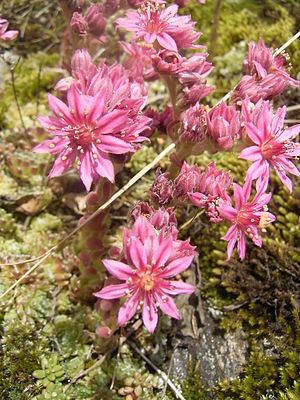Cobweb houseleek
| Cobweb houseleek | ||||||||||||
|---|---|---|---|---|---|---|---|---|---|---|---|---|

Cobweb houseleek ( Sempervivum arachnoideum ) |
||||||||||||
| Systematics | ||||||||||||
|
||||||||||||
| Scientific name | ||||||||||||
| Sempervivum arachnoideum | ||||||||||||
| L. |
The Sempervivum Arachnoideum ( sempervivum arachnoideum L. , Syn. : Sedum arachnoideum (L.) EHL Krause , sempervivum sanguineum Jeanbernat ex Timbal-Lagrave , too) cobwebs Hauswurz called, is a kleinrosettige Hauswurzart .
description
The plants are cushion-forming, with at least in the growing season more or less strong spider-web hairs that connect the leaf tips with each other. The individual rosettes usually have a diameter of 0.5 to 2 cm. The flowers are pale pink to intense pink, with a central line in the petals. The flower shoots tower above the rosettes and reach a height of up to 18 cm. Like all species of the genus, the plants are succulent and can withstand longer periods of drought.
The chromosome number is or .
Occurrence
The cobweb houseleek has its natural distribution in the European mountains from the Pyrenees to the Eastern Alps and south to the Apennines and Corsica. It often grows on rocks, rubble, pastures and meadows. It prefers acidic soil on a silicate substrate and grows from 280 m (in southern Switzerland) to 2900 m in the Aosta Valley. In the Allgäu Alps, it rises in the Tyrolean part on the chert slopes of the Jöchelspitze near Holzgau up to 2100 meters above sea level.
ecology
The seeds can gain a foothold on thin lichen growth as well as in fine pores or cracks in the rock. The plant grows very slowly and is therefore dependent on no other flowering plants competing.
Systematics
There are two subspecies:
- The common cobweb houseleek ( Sempervivum arachnoideum subsp. Arachnoideum ) occurs from the Pyrenees to far into the Eastern Alps . The leaf rosettes are up to 12 mm wide.
- The felty cobweb houseleek ( Sempervivum arachnoideum subsp. Tomentosum (CB Lehm. & Schnittspahn) Schinz & Thell. ) Is widespread in the Eastern Pyrenees, southern Alps, east to South Tyrol and in the Apennines and is also found in Corsica. In Switzerland it occurs in Graubünden, Ticino and Valais. This subspecies shows strong, white felt hair on the rosettes. The up to 35 mm wide rosettes are strongly flattened at the top. It also has the chromosome number 2n = 64.
use
The species is often cultivated in rock gardens.
swell
- Gustav Hegi : Illustrated flora of Central Europe. Volume IV, Part 2 A. 2nd edition. Carl Hanser Verlag, Munich 1961–1966.
- Henk 't Hart, Bert Bleij, Ben Zonneveld: Sempervivum . In: Urs Eggli (Ed.) Succulent lexicon. Crassulaceae (thick leaf family) . Eugen Ulmer, Stuttgart 2003, ISBN 3-8001-3998-7 , p. 349 f.
- Manuel Werner: Houseleek species in the Alps. Sempervivum and Jovibarba . In: Avonia . Volume 28, Number 4, 2010, pp. 131-138.
supporting documents
- ↑ a b Sempervivum arachnoideum at Tropicos.org. In: IPCN Chromosome Reports . Missouri Botanical Garden, St. Louis
- ↑ Erhard Dörr, Wolfgang Lippert : Flora of the Allgäu and its surroundings. Volume 1, IHW, Eching 2001, ISBN 3-930167-50-6 , p. 637.
- ↑ Jaakko Jalas, Juha Suominen, Raino Lampinen, Arto Kurtto: Atlas florae europaeae . Volume 12: Resedaceae to Platanaceae. Helsinki 1999, ISBN 951-9108-12-2 , pp. 56-57.
Web links
- Cobweb houseleek. In: FloraWeb.de.
- Cobweb houseleek . In: BiolFlor, the database of biological-ecological characteristics of the flora of Germany.
- Profile and distribution map for Bavaria . In: Botanical Information Hub of Bavaria .
- Sempervivum arachnoideum L. In: Info Flora , the national data and information center for Swiss flora . Retrieved November 1, 2015.
- Thomas Meyer: Data sheet with identification key and photos at Flora-de: Flora von Deutschland (old name of the website: Flowers in Swabia )



